Back to Basics
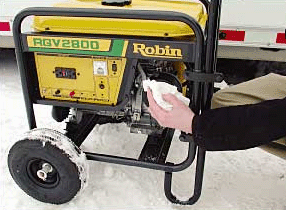 All photos courtesy of Robin Subaru. |
Fuel School
One of the most common problems associated with generators is dirty fuel and the effects it has on a generator engine. Dirty fuel is a result of improper fuel storage or refilling tanks in dusty conditions. If operators don't take the time to prevent dirty fuel, they can run into problems with clogged fuel lines and carburetors, which can be expensive to replace.
To prevent dirty fuel from entering a generator, store fuel in an OSHA-approved receptacle and keep it out of high traffic areas where dust and debris can contaminate. When refilling, move the generator out of windy conditions where dust is more likely to enter the fuel tank.
In addition to keeping the fuel clean, it is important to refill under proper conditions. Adding fuel while the unit is running is extremely hazardous. Gasoline vapors can ignite when they come in contact with hot components such as the muffler, exhaust fumes or an electrical spark, resulting in an explosion that will not only severely damage the generator, but also cause serious harm to the operator. To prevent such a disaster, shut the generator down and allow ample cooling time before refilling.
Another hazard associated with fuel is overfilling. Spilled fuel poses the same threat as fuel vapors when exposed to hot surfaces and electric sparks. To prevent spillage, keep the fuel level to one-half inch below the tip of the fuel tank. If a spill occurs when refilling, replace and tighten the cap and move the generator away from the spill before starting it.
Oil Toils
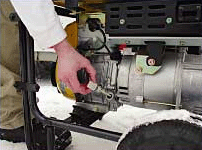 Adequate lubrication is just as essential to generator engines as clean fuel. Maintaining the proper oil level is crucial. For a frequently used generator, engine oil should be checked before each use and topped off as needed.
Adequate lubrication is just as essential to generator engines as clean fuel. Maintaining the proper oil level is crucial. For a frequently used generator, engine oil should be checked before each use and topped off as needed.
Oil changes should take place according to the schedule in the generator owner's manual, usually every 50 to 100 hours, depending on usage. If your generator does not come equipped with an hour meter, it may be useful to keep a notebook close by to keep track of how often the generator is used and for how long. Also, keep an eye on oil consistency and clarity. You may not know how long it has been, but if the oil is black and opaque, it's probably time for a change.
As with refueling, it is important to avoid overfilling. When an engine contains too much oil, it will start burning oil and producing black exhaust, which has potentially damaging effects on the engine. Although most generator engines come equipped with a low-oil shutdown feature that protects it from damage associated with low oil, keeping the oil level topped off will provide further protection.
Visual Inspection
Along with checking oil, it is a good idea to give a quick visual inspection of the unit before each use. Open up the air cleaner assembly and look at the air filter. If it looks dirty or plugged, replace it with a new one. Start the engine and look for anything that is loose or vibrating. If any adjustments need to be made, shut the engine down before tightening.
Look at the generator itself. It should be clean and dry. If it looks dirty, wipe it down with a clean cloth or a soft bristle brush to remove dust particles and other debris. Do not wash with a garden hose or pressure washer. These can introduce water into the cooling air slots and possibly damage the rotor, stator and internal windings of the generator head.
Taking only a few minutes to visually inspect a generator before each use can add hundreds of operating hours to the life of the unit.
Location, Location, Location
Maintaining fuel and oil systems is useless if the generator is not placed in a safe operating location. The position of a generator can mean the difference between a reliable piece of equipment and a maintenance headache. Always operate generators on a level surface. Operating on an angle can cause the lubrication system to fail, locking up all the critical moving parts of the engine. In addition, an angular placement can throw off the fuel level in the carburetor, disrupting the spark plugs, pistons and crankcase.
Generators resting on soft ground, like sand or soil, will often dig themselves into the ground from vibration, creating an uneven surface that will have the same effect as setting it on an angle. In addition, discharged air from the generator will stir up dust that can be sucked into the air cleaner, shortening service life. Dust can also be trapped in the cooling air, damaging the generator's rotor, stator and windings. If a generator must be operated on soft surfaces, set it on top of a piece of plywood or a stable platform to avoid the damaging consequences of dust.
In addition, the effects of bad weather can be detrimental. Generators are often used in rainy or icy conditions; however, rain and ice are potentially very damaging to generator components.
Water conducts electricity. When it comes in contact with electrically charged components, it can transmit electricity to other surfaces on the unit, greatly increasing the risk of electrical shock to operators. Additionally, icing can occur on the carburetor, the crankcase and the breather system, causing serious damage to the engine.
To avoid these situations, some operators will place a generator in an enclosed area. This can actually be much more harmful as generators produce carbon monoxide ? a clear, odorless gas that can be deadly when inhaled. Another common mistake is building a small, encasing structure around the generator. This is potentially dangerous because generators need an unlimited amount of ambient air to breathe properly. Encasing them in a small structure will "suffocate" the breather system and cause the engine to overheat, greatly increasing the risk of fire.
Rather than risking fire or exposure to carbon monoxide, position the generator in a location where it is sheltered from the elements, but still has room to breathe ? about two feet on all sides.
The Factory Knows Best
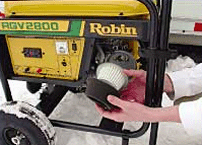 Beyond suggested maintenance procedures and placement, some operators believe they can improve the performance of their generator by tampering with factory-installed governors and speed settings. In reality, generators are manufactured with the exact engine speed needed to produce the specified wattage.
Beyond suggested maintenance procedures and placement, some operators believe they can improve the performance of their generator by tampering with factory-installed governors and speed settings. In reality, generators are manufactured with the exact engine speed needed to produce the specified wattage.
Tampering with engine speed can result in overheating and blowing out tools and attachments connected to the generator. Also, adjusting the speed setting will often cancel out any warranty coverage from the manufacturer.
If a generator isn't performing as well as it should, check oil and fuel levels, inspect the air filter and reduce the load rather than adjusting the engine speed.
Additionally, most manufacturers will set up a schedule in the owner's manual of when to perform maintenance tasks. Always refer to the owner's manual when performing maintenance and call a dealer with any questions. Straying from the schedule or ignoring it all together will result in a shorter life span for a portable generator.
Off-Season Storage
Another very important, yet often ignored, aspect of generator maintenance is preparing for off-season storage. Before storing a generator for 30 days or more, some important steps should be taken to ensure it maintains its performing condition. A common problem associated with generator storage is stale fuel. When a fuel tank is left partially full and rests for more than a month or two, it becomes stale from the air in the tank. This can be solved by completely draining the fuel tank before storage. Another option is to fill the tank completely and add a fuel stabilizer. A fuel stabilizer will minimize the formation of fuel gum on the carburetor during storage and prevent the fuel from going stale.
After draining or filling the fuel tank, clean the generator, as stated earlier, using a cloth or soft brush. Check that all of the cooling air slots and openings are open and unobstructed. Remove the battery and clean the posts. The battery should be fully charged before storage, keeping in mind it may need to be recharged after a long storage.
Generators that will be stored for several months need to be exercised every two to three months. Start the generator and run it for at least 10 minutes carrying a load. This burns off any moisture that has settled inside and prevents corrosion.
When working with something as reliable as a portable generator, it's easy to let preventative maintenance slip through the cracks. However, neglecting simple maintenance tasks can result in costly repair and replacement fees. Devote a little time to generator maintenance, and your machine will not only be safer and more productive, but it will also last for years to come.
New Portable Power
Several companies have introduced new onsite power products to the market this year that will fill almost any need, from big to small.
Bosch
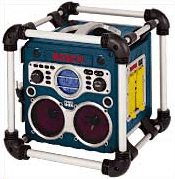 In April, Bosch Power Tools and Accessories, a division of the Robert Bosch Tool Corporation, launched its one-of-a-kind Bosch Power Box? (PB10-CD). The Power Box is an all-in-one power center and job site radio/CD player with a four-way GFCI power outlet, integrated battery charger for 12-, 14.4-, 18- and 24-volt Bosch batteries, and 12-volt outlet perfect for charging cell phones and two-way radios. An aluminum roll cage prevents damage from everyday job site abuse, and features like sealed buttons, speakers, battery chamber and CD player assure protection from the elements. For more information, visit www.boschtools.com.
In April, Bosch Power Tools and Accessories, a division of the Robert Bosch Tool Corporation, launched its one-of-a-kind Bosch Power Box? (PB10-CD). The Power Box is an all-in-one power center and job site radio/CD player with a four-way GFCI power outlet, integrated battery charger for 12-, 14.4-, 18- and 24-volt Bosch batteries, and 12-volt outlet perfect for charging cell phones and two-way radios. An aluminum roll cage prevents damage from everyday job site abuse, and features like sealed buttons, speakers, battery chamber and CD player assure protection from the elements. For more information, visit www.boschtools.com.
Multiquip
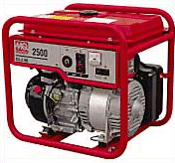 Multiquip's new GA-Series offers seven models, ranging from the 2.5kW GA-2.5H to the GA-9.7HE that generates 9.7kW. Each unit is wrapped with a thick one-inch steel frame for improved durability and additional twist-receptacles so the operator can use more tools on the job. The generators are fitted with a rugged new-look control panel and the choice of powerful Honda GX-Series or Robin EX-Series industrial grade engines. As with the predecessor, the new GA-Series incorporates the highest quality generator ends constructed with 100% copper windings and brushless alternator designs. This design ensures longer life for the alternator and outstanding voltage regulation for any tools powered by GA-Series units. For more information, visit www.multiquip.com.
Multiquip's new GA-Series offers seven models, ranging from the 2.5kW GA-2.5H to the GA-9.7HE that generates 9.7kW. Each unit is wrapped with a thick one-inch steel frame for improved durability and additional twist-receptacles so the operator can use more tools on the job. The generators are fitted with a rugged new-look control panel and the choice of powerful Honda GX-Series or Robin EX-Series industrial grade engines. As with the predecessor, the new GA-Series incorporates the highest quality generator ends constructed with 100% copper windings and brushless alternator designs. This design ensures longer life for the alternator and outstanding voltage regulation for any tools powered by GA-Series units. For more information, visit www.multiquip.com.
Robin Subaru
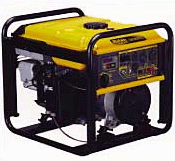 Robin Subaru introduces the Power Series, a new line of automatic voltage regulation (AVR) portable generators known for high performance, quiet operation and ease-of-use. The Power Series includes models R1100, RG2800DX, RG3200DX and RG4300DX, generating maximum outputs ranging from 1,100 watts to 4,300 watts. Power Series generators offer clean and stable power through the use of advanced automatic voltage regulation (AVR) technology. Utilizing an exclusive advanced reverse cooling technology, the Robin Subaru Power Series generators also run quieter than most AVR generator technologies. All Power Series generators come with a unique one-touch control system that allows all engine functions to be controlled with a turn of a dial. For more information, visit www.robinsubaru.com.
Robin Subaru introduces the Power Series, a new line of automatic voltage regulation (AVR) portable generators known for high performance, quiet operation and ease-of-use. The Power Series includes models R1100, RG2800DX, RG3200DX and RG4300DX, generating maximum outputs ranging from 1,100 watts to 4,300 watts. Power Series generators offer clean and stable power through the use of advanced automatic voltage regulation (AVR) technology. Utilizing an exclusive advanced reverse cooling technology, the Robin Subaru Power Series generators also run quieter than most AVR generator technologies. All Power Series generators come with a unique one-touch control system that allows all engine functions to be controlled with a turn of a dial. For more information, visit www.robinsubaru.com.
Terex
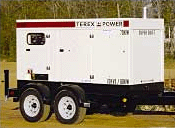 Terex has introduced a new generation of Super Quiet Power Generators, including 13 models with prime power outputs from 20-406 kVA (16-325 kW). Terex Power Generators are designed and built to deliver high quality and high value to the rental industry and the jobsite. All models simultaneously deliver both single and three-phase outputs. The power side of the control panel on these models includes a main breaker, two GFCI duplex receptacles and two to three Tempower Twistlock. These models are driven by powerful yet fuel-efficient diesel engines from Deere, Perkins or Isuzu, and have a run time at 75% load ranges up to 78 hours on a single tank of fuel. For more information, visit www.terex.com.
Terex has introduced a new generation of Super Quiet Power Generators, including 13 models with prime power outputs from 20-406 kVA (16-325 kW). Terex Power Generators are designed and built to deliver high quality and high value to the rental industry and the jobsite. All models simultaneously deliver both single and three-phase outputs. The power side of the control panel on these models includes a main breaker, two GFCI duplex receptacles and two to three Tempower Twistlock. These models are driven by powerful yet fuel-efficient diesel engines from Deere, Perkins or Isuzu, and have a run time at 75% load ranges up to 78 hours on a single tank of fuel. For more information, visit www.terex.com.
About the Author
Dale Gabrielse is the Training Manager at Robin America.


















